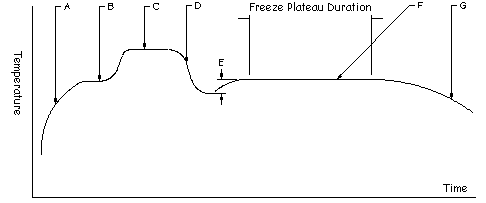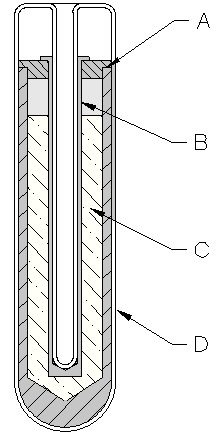Realising Aluminium and Silver Points
Reproduced from reference manuals of Isothermal Technology
REALISING THE FOLLOWING FIXED POINTS: ALUMINIUM AND SILVER
These metals are characterised by a relatively short supercool (supercool is the characteristic of a freezing pure metal to remain liquid at a temperature below that at which the solid melts). The supercool of these metals can be expected to be less than 0.5°C.
The cell is placed in the furnace, suitable insulation and cover added and a monitoring thermometer inserted. The furnace controller is set 5°C to 10°C above the expected melt temperature. The temperature rise is monitored with a bridge and/or recorder connected to the thermometer.
Following the melt arrest, the temperature of the cell will rise to the controlled temperature. The metal in the cell is now entirely in the liquid phase and may be maintained in this condition for any desired period of time, for example, to accommodate to a calibration schedule.
To freeze, the furnace controller is set below the actual freeze temperature (for pure metals, melt and freeze temperatures are theoretically identical). The suggested setting is 1°C below the freeze temperature; this is, assuredly, below the bottom of the supercool. The furnace is allowed to cool to this new setpoint temperature, taking typically 30 to 45 minutes to do so.
When the monitor indicates that the cell is at, or below, its freeze temperature, the monitor is removed to a rack and replaced by a cold rod of quartz. This initiates nucleation. After 2 minutes the rod can be removed and replaced by the monitor again.
This procedure creates a radial freeze from the inside and outside walls of the cell towards the centre.
A typical melt/freeze sequence is shown in Figure 1.
If the cell is left too long in the furnace without initiating the freeze as described above, nucleation will occur and the cell will begin to freeze from the bottom of the cell upwards.
This will result in a short, imperfect, plateau and, moreover, give an incorrect value of freeze point (typically 10mK below that expected).
Depending upon factors such as furnace control and the number of thermometers successively loaded into the cell, plateau durations between an hour and many hours may be achieved. Thermometers may be preheated prior to transfer to the cell. A pocket is provided in the furnace for this purpose. It is wise to ascertain from time to time that the plateau is still in existence, by checking the cell temperature with the monitoring thermometer at intervals within the measurement sequence. Let us suppose that Thm is the monitoring thermometer and Th1...n are thermometers to be calibrated. If n=2 a suitable sequence might be
Thm, Th1, Thm, Th2, Thm
and if n=4
Thm, Th1, Th2, Thm, Th3, Th4, Thm
The Thm measured last should be equal in indication to that of the Thm measured first to ensure that the plateau has been present for Th1, etc.
At the temperatures of Indium and Zinc it is generally permissible to withdraw a thermometer, of type Isotech 909, directly into room temperature. After exposure to Aluminium and Silver Point temperatures, slow cooling is vital to ensure that thermometer characteristics remain unaltered.
A USEFUL HINT
When first creating freezes use large under settings - typically 3 to 5°C BELOW the freeze plateau. The result will be a shorter freeze time than ideal, but will engender confidence in establishing a plateau. Once familiar with the procedure using coarse settings, on subsequent exercises bring the setting of the controller closer to the known freeze temperature to increase the plateau length.

Figure 1
A Initial temperature rise
B. Temperature arrest during melt
C Furnace-controlled temperature
D Temperature drop caused by furnace controller adjustment after completion of freeze
E Depth of supercool (particularly pronounced for tin)
F Plateau showing constant temperature during freeze
G Temperature drop
THERMOMETRIC FIXED POINTS
A TUTORIAL
The International Temperature Scale, the scale most used in science and industry, is based on a series of fixed point temperatures. Fixed points involve two-phase or three-phase equilibria of, ideally, pure materials to which constant temperature values have been assigned by primary thermometry. Defining fixed points are chosen to be as few in number as is consistent with the need to establish satisfactory interpolation procedures.
There are secondary reference points which, also, are two-phase or three-phase equilibria of very pure materials, whose temperature values have been established by measurements made with interpolation instruments calibrated at the defining fixed points. Secondary reference points are useful for the calibration of thermometers having total ranges shorter than the interpolation ranges of the Scale. Generally, secondary points are admitted to the Scale only if the material is generally available in high purity and if sufficient reproducibility of the equilibrium temperature has been confirmed by measurements made independently by a considerable number of investigators. An average value (weighted according to individual uncertainties) is then used as the ITS temperature value.
Two-phase equilibria may be solid-liquid, liquid-vapour, or solid-vapour. From the Phase Rule of Gibbs:
P + F = C + 2
P is an integer equal to the number of phases present, C is the number of components present - for a pure material C = 1 - and F is an integer representing the number of degrees of freedom. It is evident that the temperatures of two-phase equilibria are pressure-dependent (one degree of freedom only) whereas equilibria in which all three phases are present (triple points) are characterised by unique values of temperature and pressure (zero degrees of freedom).
A necessary condition to establish a triple point is to contain the appropriate material in a sealed enclosure from which all other materials, including air, have been evacuated, leaving a space to be filled by the vapour phase at a pressure appropriate to the temperature. When the three-phase (solid, liquid, vapour) condition has been established, these parameters will settle to their unique triple-point values.
The defining fixed points above 0°C are liquid-solid equilibria of high-purity metals. Pressure-dependence is small (see the table on page 21) and thermal capacity and thermal conductivity are relatively high. Metals are generally available with a purity of 99.999% ("five-nines") or 99.9999% ("six-nines").
Figure 1 shows the design of a cell for realising the liquid-solid equilibrium of pure metal. The metal is contained in a crucible of purified graphite, with a graphite cover and a graphite re-entrant sleeve. The crucible is enclosed in an envelope of fused quartz, which extends into the sleeve interior to form the thermometer well. The cell is charged with a pure metal, purged and filled with sufficient argon (or another inert gas) to give a pressure of 101kPa (1 standard atmosphere) at the freezing temperature and then sealed. Thus it is at once protected from contamination and supplied with an inert atmosphere at the required pressure at the equilibrium temperature. A correction for the effect of change in ambient pressure on freezing point need not be made. Sealed cells of this type have shown no measurable change after 15 years of use.
In general, sealed fixed-point cells are used in vertical-tube furnaces which provide good temperature control and sufficient cell immersion to make axial temperature gradients, in the measurement zone, negligible. With the cell in the furnace, the controller is first set about 5°C above the anticipated value corresponding to the melting temperature of the metal in the cell. The onset of melting is indicated by a cessation of temperature rise because of the latent heat required to produce the phase change. This melt plateau can last for a considerable period of time. When melting is complete, the cell temperature will rise to the furnace temperature.
The furnace temperature is then reduced to a value slightly below the melt temperature. The temperature falls until the first solid nucleus of metal is formed, at which stage the temperature drop is arrested. With both liquid and solid metal present in the cell, a constant temperature is maintained by the latent heat released by the freezing metal. The controller temperature setting will cause the rate of heat egress from the cell to be relatively low, thus generating a freeze plateau that can usually be maintained for a number of hours, during which time thermometers may be calibrated.
A variation on this is the establishment of the triple point of mercury. Since this temperature is below normal ambient, the apparatus in which the point is realised must provide refrigeration as well as controlled heat. A separate manual describes the use of this apparatus.
Another variation is the realisation of the melting point of gallium. This metal is used on the melt plateau rather than on the freeze plateau. A separate manual describes the use of the apparatus for realising this fixed point.
DEFINING FIXED POINTS AND RELATED DATA
| FIXED POINT | ITS 90 TEMP. | PRESSURE COEFFICIENT | Isotech Cell Designation | Suitable Isotech Apparatus for Cell Operation | ||
| °C | K | mK/bar | mK/m Head of Substance | |||
| Aluminium FP | 660.323 | 933.473 | +7.0 | +1.6 | ITL-M-17672 | ITL-M-17702** |
| Silver FP | 961.78 | 1234.93 | +6.0 | +5.4 | ITL-M-17673 | ITL-M-17702** |
NOTES
Pressure corrections that apply to triple point and to other sealed-cell measurements are determined solely by the pressure head of material in the cell; variability of atmospheric pressure has no effect on the measurements.
* Furnace with potassium heat-pipe for zinc freezing point.
** Furnace with either potassium or sodium heat pipe at aluminium and silver freezing points.
An Isotech Sealed Fixed Point Cell

A High-purity graphite crucible and cover
B High-purity graphite sleeve
C High-purity metal
D Fused-quartz envelope, filled to give a pressure of 1 standard atmosphere at the metal freezing temperature
PRECAUTIONS TO PREVENT DEVITRIFICATION OF QUARTZ ENVELOPES
The crucibles (containing the metal) of Isotech sealed fixed point cells are encased in an envelope of pure fused quartz, whose purpose is to avoid contamination of the enclosed metal, by foreign metal ions or oxygen. To this end, it contains an inert gas whose pressure is 1 standard atmosphere at the metal freezing temperature.
Fused quartz is vitreous in nature but, like other glasses, can be stimulated to crystallise (devitrify) by external influences at high temperatures. The crystalline form is recognisable as a localised cloudy or milky appearance. Devitrification is progressive and irreversible.
A devitrified cell can no longer be assumed to be gas-tight. It may leak its enclosed gas and atmospheric air may leak into it. The pressure at the freeze point may, as a consequence, be incorrect and, more seriously, contamination may occur.
Sealed quartz cells can be used for thousands of hours without devitrification if precautions are taken to ensure that the outside surface is scrupulously clean before raising them to temperature. Any surface dirt, a water spot or a single fingerprint is a potential seed for devitrification. Before exposing to high temperature, the cell and well may be cleaned with copious isopropanol and permitted to air-dry in a dust-free atmosphere. The isopropanol should run off the surface of the quartz in a sheet. In extreme cases, an Alconox wash followed by an isopropanol rinse may be necessary. It is advisable to handle cells with clean cloth gloves.
The precaution applies particularly to cells for use at temperatures in excess of 500°C, although Isotech advises that all cells be carefully cleaned before use.
